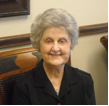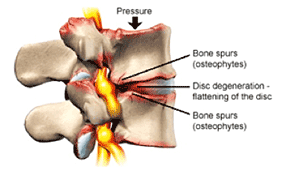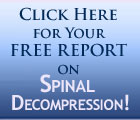STOP Living in Pain Today! • (480) 926-7100 • Call NOW For a FREE ConsultationContact Us
East Valley Spinal Decompression Center
|
|


"I Can Stand and Walk Straight For the First Time in 30 Years"
- Joe A.

"...the greatest gift I have
received in all my life...."
- Joyce B.

"I was unable to bend over enough to dress myself.... My back is completely restored"
- Robert H.

"If it wasn't for the doctor and spinal decompression I would not have been able to continue my job as a meat cutter"
- Leandro M.
Degenerative Disc Disease (DDD)
What is Degenerative Disc Disease?

Degenerative disc disease is not really a disease but a term used to describe the normal changes in your spinal discs as you age. Spinal discs are soft, compressible discs that separate the interlocking bones (vertebrae) that make up the spine. The discs act as shock absorbers for the spine, allowing it to flex, bend, and twist. Degenerative disc disease can take place throughout the spine, but it most often occurs in the discs in the lower back (lumbar region) and the neck (cervical region).
These conditions may put pressure on the spinal cord and nerves, leading to pain and possibly affecting nerve function.
What causes Degenerative Disc Disease?
As we age, our spinal discs break down, or degenerate, which may result in degenerative disc disease in some people. These age-related changes include:
- The loss of fluid in your discs. This reduces the ability of the discs to act as shock absorbers and makes them less flexible. Loss of fluid also makes the disc thinner and narrows the distance between the vertebrae.
- Tiny tears or cracks in the outer layer (annulus or capsule) of the disc. The jellylike material inside the disc (nucleus) may be forced out through the tears or cracks in the capsule, which causes the disc to bulge, break open (rupture), or break into fragments.
These changes are more likely to occur in people who smoke cigarettes and those who do heavy physical work (such as repeated heavy lifting). People who are obese are also more likely to have symptoms of degenerative disc disease.
A sudden (acute) injury leading to a herniated disc (such as a fall) may also begin the degeneration process.
As the space between the vertebrae gets smaller, there is less padding between them, and the spine becomes less stable. The body reacts to this by constructing bony growths called bone spurs (osteophytes). Bone spurs can put pressure on the spinal nerve roots or spinal cord, resulting in pain and affecting nerve function.
What are the Symptoms?
Degenerative disc disease may result in back or neck pain, but this varies from person to person. Many people have no pain, while others with the same amount of disc damage have severe pain that limits their activities.
With symptomatic degenerative disc disease, chronic low back pain sometimes radiates to the hips, or there is pain in the buttocks or thighs while walking; sporadic tingling or weakness through the knees may also be evident. Similar pain may be felt or may increase while sitting, bending, lifting, and twisting. Chronic neck pain can also be caused in the upper spine, with pain radiating to the shoulders, arms and hands. Where the pain occurs depends on the location of the affected disc. An affected disc in the neck area may result in neck or arm pain, while an affected disc in the lower back may result in pain in the back, buttocks, or leg. The pain often gets worse with movements such as bending over, reaching up, or twisting.
How does Spinal Decompression help Degenerating Discs?
While lying comfortably on the spinal decompression table, gentle specialized traction forces are logrhythmically applied until decompression is achieved. Decompression produces a negative pressure inside the discs that act like a vacuum. This negative pressure produces an influx of fluid and minerals which helps the discs to heal. Then with the addition of specific nutrients and minerals through supplements, the influx helps the discs to regenerate up to a certain point.
As disc bulges or herniations are drawn in, or as the discs begin to regenerate, pressure is taken off of the nerves and surrounding structures relieving the patient of pain and inflammation. So instead of sweeping the dust under the rug, we actually attempt to fix the problem!
http://www.webmd.com/back-pain/tc/degenerative-disc-disease-topic-overview
How Does Spinal Decompression Work?
Non-Surgical Spinal Decompression, not to be confused with linear traction, slowly lengthens and decompresses the spine, creating negative pressures within the discs.This reversal of pressure creates an intradiscal vacuum that helps to reposition bulging discs and pull extruded disc material back into place, taking pressure off pinched nerves. Spinal experts believe that nutrients, oxygen, and fluids are drawn into the disc to create a revitalized environment conducive to healing.
What are the Treatments Like?
At the beginning of each session, you will be comfortably fitted with a harness designed to achieve optimal decompression of the low back or neck. During a session of spinal decompression, you will notice a slow lengthening of your spine as your discs are gradually decompressed and relieved of pressure. The treatment process is safe and relaxing. While some patients with extensively injured discs have reported mild discomfort during the first few treatment sessions, their discomfort subsides upon subsequent visits. A patient safety switch provides an extra safety feature, allowing you to stop at any point should you feel discomfort. Each treatment session lasts approximately 30 minutes. Individual patient results may vary.
What is the Typical Treatment Protocol?
A typical spinal decompression treatment protocol consists of about 20-25 sessions over four to six weeks. Some conditions require fewer visits; some require more. Many patients report relief from their pain and other symptoms during the first few treatment sessions, and most experience dramatic pain relief after completion of their prescribed treatment program.
Why Is Spinal Decompression Different from Traction? Why are Some Spinal Decompression Tables Better Than Others?
While traction, physical therapy, and manipulation may reduce disc pressures to as low as 40 mm Hg, only spinal decompression has been shown to achieve negative pressures within the spine. It has been clinically proven that spinal decompression creates negative pressures as low as -110 mm Hg3 within the injured disc during the treatment session. Normally, pulls exerted on the spine trigger sensory receptors in the back to tighten the muscles surrounding the vertebrae and discs in an effort to protect them from injury,a mechanism in the body known as the proprioceptor response. Spinal Decompression bypasses this response by slowly pulling on the spine and relaxing the back over an extended period of time, allowing the spine to be repositioned without tension and without setting off the "Iock down" proprioceptor response. It is important for patients to make sure that they are treated on a high quality spinal decompression table and not an imitation spinal decompression table.
If you have more questions please go to the Frequently Asked Questions Section (FAQ's) or call us anytime.
How Do I Get Started?
Call Us At:
(480) 926-7100
To schedule an initial consultation with the Doctor nearest you to determine if you are a candidate for care with Spinal Decompression. After carefully studying your case history and exam findings, your Doctor will sit down and determine if you qualify for Spinal Decompression Therapy treatment. If you do qualify for care, your Doctor will explain their recommended plan of action for you. After answering any questions you may have about the recommended plan, you may begin your care.
Treat serious back pain, sciatica, herniated disc, degenerative or bulging disc, or spinal stenosis with non surgical spinal decompression. Learn more about this safe and easy back pain treatment offered by East Valley Spinal Decompression Center and all of our chiropractic services; read testimonials and spinal decompression reviews from many satisfied clients and residents of Gilbert, Mesa, Chandler, Tempe, and Apache Junction, Arizona.

©2008-2010 East Valley Spinal Decompression Center ![]()
![]()
![]()
![]() designed by jeff thomason, ce
designed by jeff thomason, ce
